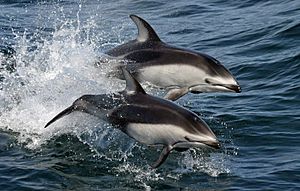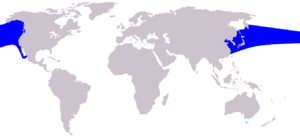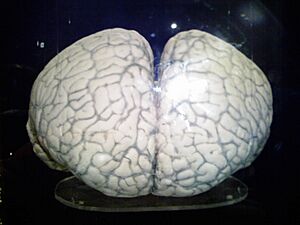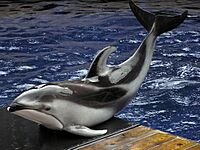Pacific white-sided dolphin facts for kids
Quick facts for kids Pacific white-sided dolphin |
|
|---|---|
 |
|
 |
|
| Size compared to an average human | |
| Conservation status | |
| Scientific classification | |
| Genus: |
Lagenorhynchus
|
| Species: |
obliquidens
|
 |
|
| Pacific white-sided dolphin range | |
The Pacific white-sided dolphin (Lagenorhynchus obliquidens) is a super active dolphin. It lives in the cool waters of the North Pacific Ocean. People sometimes call it the hookfin porpoise.
Contents
About the Pacific White-Sided Dolphin
The Pacific white-sided dolphin was first named by a scientist named Theodore Gill in 1865. It looks a lot like the dusky dolphin, which lives in the South Pacific. Scientists think these two dolphin types started to become different species about two million years ago.
Scientists are still learning about the exact family tree of these dolphins. They used to think these dolphins were closely related to the Atlantic white-sided dolphin. But new studies show they might be closer to other dolphin groups. This means their scientific name might change in the future!
What Does a Pacific White-Sided Dolphin Look Like?
Pacific white-sided dolphins have three main colors. Their chin, throat, and belly are a creamy white. Their snout, fins, back, and top fin (dorsal fin) are dark gray. They have cool light gray patches on their sides. A light gray stripe also runs from above their eye to below their dorsal fin. This stripe gets wider near their tail. A dark gray ring goes around each eye.
These dolphins are a medium size for ocean dolphins. Female dolphins can weigh up to 150 kilograms (about 330 pounds). Males can be heavier, up to 200 kilograms (about 440 pounds). Males can grow to be 2.5 meters (about 8 feet) long. Females are a bit shorter, reaching 2.3 meters (about 7.5 feet).
Female dolphins are ready to have babies when they are about seven years old. They are pregnant for about one year. These amazing animals can live for 40 years or even longer!
Pacific white-sided dolphins are very playful and active. They often swim with other ocean animals. They love to swim near boats and ride the waves at the front of the boat (this is called bow-riding). They usually live in large groups, with about 90 dolphins together. Sometimes, you can see supergroups with more than 300 dolphins!
They eat mostly fish like hake, anchovies, herring, salmon, and cod. They also enjoy eating squid. These dolphins have about 60 teeth to help them catch their food.
Where Do Pacific White-Sided Dolphins Live?
Pacific white-sided dolphins live in the cool and mild waters of the North Pacific Ocean. You can find them as far south as the South China Sea on the western side. On the eastern side, they live as far south as the Baja California Peninsula. They also live in the Sea of Japan and the Sea of Okhotsk. Some even go up into the Bering Sea in the north.
These dolphins seem to move around with the seasons. On the eastern side, you'll see more of them near Southern California Bight in winter. But in summer, they travel further north to places like Oregon and Washington. They prefer to live in deep waters far from shore all year long.
The main animal that hunts Pacific white-sided dolphins is the killer whale. There has also been at least one time a great white shark was seen hunting them.
Scientists think there might be as many as 1 million Pacific white-sided dolphins in the world. But it's hard to count them exactly. This is because they love to swim close to boats, which makes surveys tricky!
How Do Pacific White-Sided Dolphins Behave?
These dolphins are very social and stick together. They swim in groups of 10 to 100 dolphins. You can often see them jumping out of the water and doing somersaults! Members of a group are very close. They will even help a sick or hurt dolphin.
Animals that live in big groups need ways to talk to each other. Each Pacific white-sided dolphin has a special "name-whistle" to identify itself. Young dolphins also communicate by gently touching an adult's fin as they swim.
Scientists have studied how these dolphins communicate. They found that Pacific white-sided dolphins make lower-pitched sounds than some other dolphins, like bottlenose dolphins. Their sounds can change depending on what they are doing. For example, their calls might sound different when they are hunting for food.
Where they live can also affect their behavior. Dolphins living near the Pacific United States seem to be more active at night. But dolphins near Baja California are more active during the day. This might be because of the seasons or when their food is available.
In 2013, a single Pacific white-sided dolphin was seen swimming with a group of killer whales near the Commander Islands. This was a very unusual sighting!
Pacific white-sided dolphins usually sleep for about seven hours each night.
Pacific White-Sided Dolphins and Humans
Right: Spinnaker, a Pacific white-sided dolphin at Vancouver Aquarium
Protecting Pacific White-Sided Dolphins
For a long time, many Pacific white-sided dolphins were accidentally caught and killed in large fishing nets called drift nets. This happened until the United Nations banned these nets in 1933. Today, some dolphins are still caught in fishing activities, especially by Japanese hunting groups.
Dolphins in Aquariums
While bottlenose dolphins are very famous, Pacific white-sided dolphins are also part of shows at some marine theme parks. About 100 of these dolphins live in aquariums in North America and Japan.
Dolphins in aquariums might eat less food than wild dolphins. This could be because the water temperature changes with the seasons. Also, the size of their tank can affect how much energy they need. Studies show that captive dolphins eat the most food in autumn. This is when they gain more body weight.
See also
- List of cetaceans
- Marine biology





